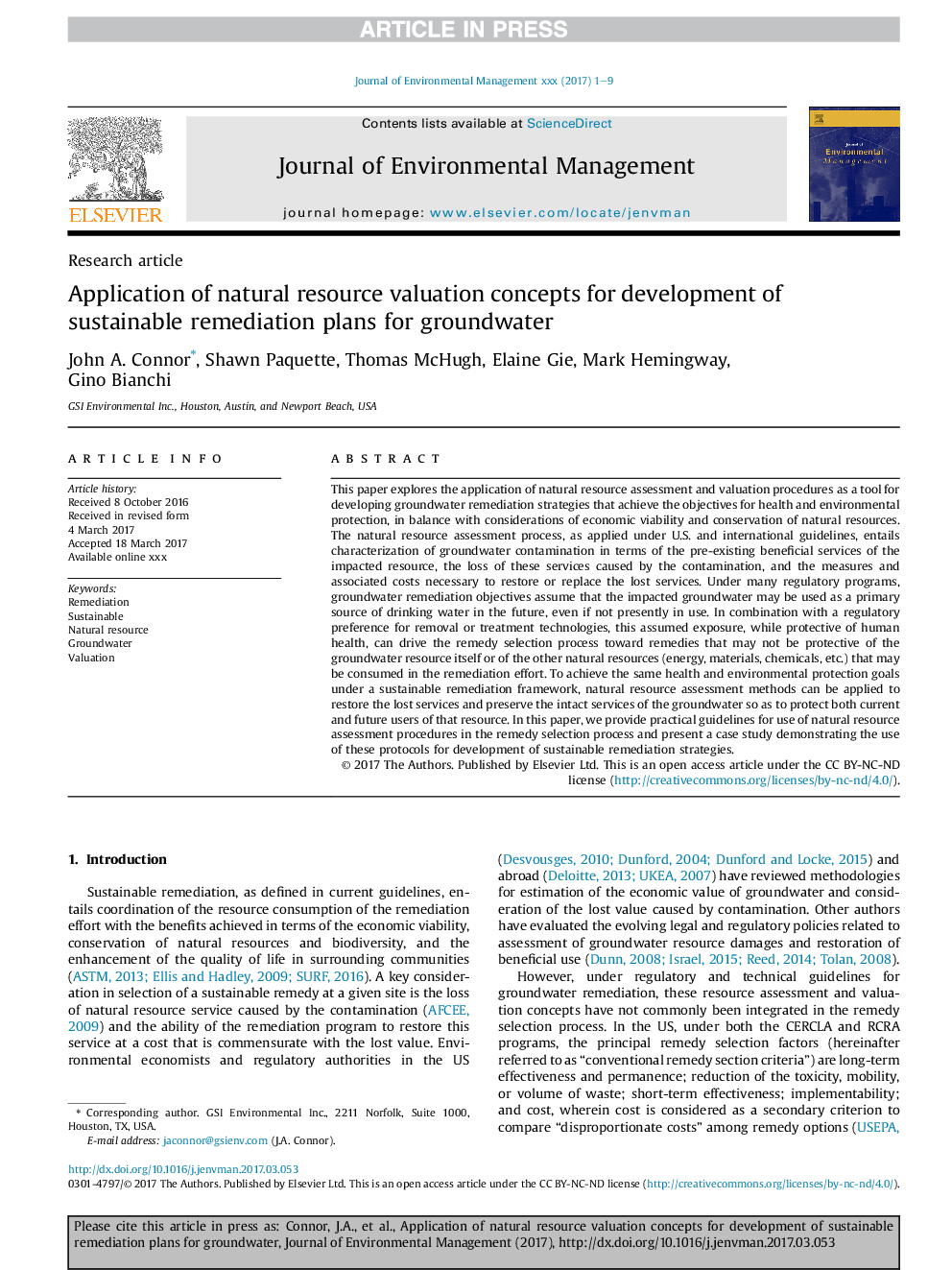| کد مقاله | کد نشریه | سال انتشار | مقاله انگلیسی | نسخه تمام متن |
|---|---|---|---|---|
| 7478746 | 1485215 | 2017 | 9 صفحه PDF | دانلود رایگان |
عنوان انگلیسی مقاله ISI
Application of natural resource valuation concepts for development of sustainable remediation plans for groundwater
ترجمه فارسی عنوان
استفاده از مفاهیم ارزیابی منابع طبیعی برای توسعه برنامه های بازسازی پایدار برای آبهای زیرزمینی
دانلود مقاله + سفارش ترجمه
دانلود مقاله ISI انگلیسی
رایگان برای ایرانیان
کلمات کلیدی
بهبود پایدار، منابع طبیعی، آب های زیرزمینی، ارزیابی،
ترجمه چکیده
در این مقاله کاربرد ارزیابی منابع طبیعی و روش های ارزیابی به عنوان ابزاری برای توسعه راهبردهای بازسازی آب های زیرزمینی که اهداف بهداشت و حفاظت از محیط زیست را در بر می گیرند، با تعادل با ملاحظات حیاتی اقتصادی و حفظ منابع طبیعی، بررسی می شود. فرایند ارزیابی منابع طبیعی، همانطور که در دستورالعمل های ایالات متحده و بین المللی اعمال می شود، مستلزم شناسایی آلودگی آب های زیرزمینی از لحاظ خدمات سودمند موجود در منابع آسیب دیده، از دست دادن این خدمات ناشی از آلودگی، و اقدامات و هزینه های مرتبط با آن است برای بازیابی یا جایگزینی سرویس های از دست رفته. در بسیاری از برنامه های نظارتی، اهداف بازسازی آبهای زیرزمینی فرض می شود که آب های زیرزمینی تحت تاثیر قرار می گیرند، ممکن است بعنوان منبع اولیه آب آشامیدنی در آینده استفاده شوند، حتی اگر در حال حاضر در حال استفاده نباشند. در ترکیب با تنظیم مقرراتی برای فن آوری های حذف یا درمان، این در معرض قرار گرفتن در معرض قرار می گیرد، در حالی که حفاظت از سلامت انسان می تواند فرآیند انتخاب درمان را به سمت راه حل هایی که ممکن است حفاظت از منابع منابع آب زیرزمینی یا سایر منابع طبیعی (انرژی، ، مواد شیمیایی، و غیره) که ممکن است در تلاش برای تصفیه مصرف شود. برای دستیابی به همان اهداف حفاظت از سلامتی و محیط زیست تحت یک چارچوب اصلاحی پایدار، روش های ارزیابی منابع طبیعی می تواند برای بازگرداندن خدمات از دست رفته و حفظ خدمات ناشی از آب های زیرزمینی استفاده شود تا از کاربران فعلی و آینده این منبع محافظت شود. در این مقاله، ما دستورالعمل های عملی برای استفاده از روش های ارزیابی منابع طبیعی در فرآیند انتخاب دارویی ارائه می دهیم و یک مطالعه موردی را نشان می دهد که نشان می دهد استفاده از این پروتکل ها برای توسعه استراتژی های اصلاحی پایدار است.
موضوعات مرتبط
مهندسی و علوم پایه
مهندسی انرژی
انرژی های تجدید پذیر، توسعه پایدار و محیط زیست
چکیده انگلیسی
This paper explores the application of natural resource assessment and valuation procedures as a tool for developing groundwater remediation strategies that achieve the objectives for health and environmental protection, in balance with considerations of economic viability and conservation of natural resources. The natural resource assessment process, as applied under U.S. and international guidelines, entails characterization of groundwater contamination in terms of the pre-existing beneficial services of the impacted resource, the loss of these services caused by the contamination, and the measures and associated costs necessary to restore or replace the lost services. Under many regulatory programs, groundwater remediation objectives assume that the impacted groundwater may be used as a primary source of drinking water in the future, even if not presently in use. In combination with a regulatory preference for removal or treatment technologies, this assumed exposure, while protective of human health, can drive the remedy selection process toward remedies that may not be protective of the groundwater resource itself or of the other natural resources (energy, materials, chemicals, etc.) that may be consumed in the remediation effort. To achieve the same health and environmental protection goals under a sustainable remediation framework, natural resource assessment methods can be applied to restore the lost services and preserve the intact services of the groundwater so as to protect both current and future users of that resource. In this paper, we provide practical guidelines for use of natural resource assessment procedures in the remedy selection process and present a case study demonstrating the use of these protocols for development of sustainable remediation strategies.
ناشر
Database: Elsevier - ScienceDirect (ساینس دایرکت)
Journal: Journal of Environmental Management - Volume 204, Part 2, 15 December 2017, Pages 721-729
Journal: Journal of Environmental Management - Volume 204, Part 2, 15 December 2017, Pages 721-729
نویسندگان
John A. Connor, Shawn Paquette, Thomas McHugh, Elaine Gie, Mark Hemingway, Gino Bianchi,
